人教新课标高中英语选修7课件:Unit 4 Sharing Warming up and reading课件(共48张PPT)
文档属性
| 名称 | 人教新课标高中英语选修7课件:Unit 4 Sharing Warming up and reading课件(共48张PPT) | 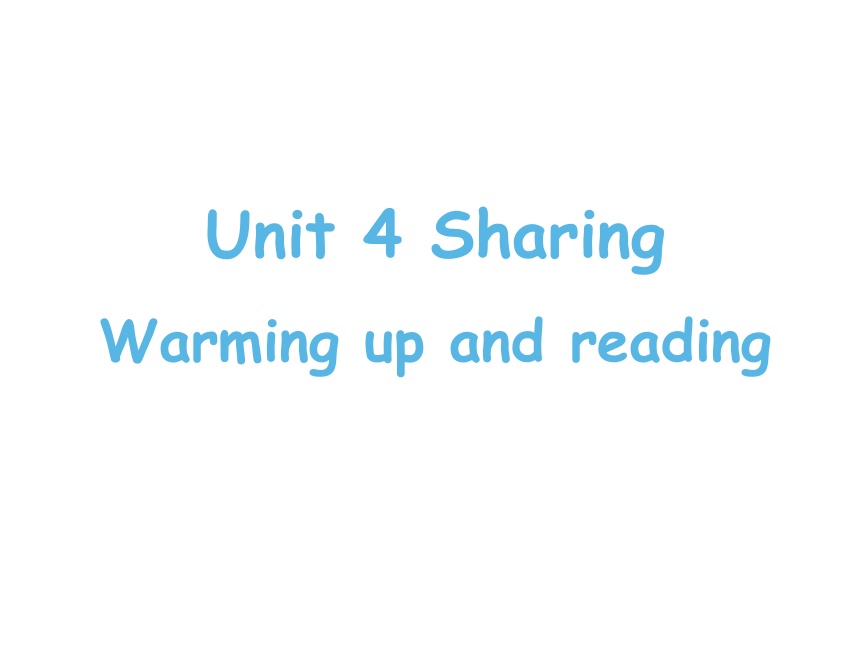 | |
| 格式 | zip | ||
| 文件大小 | 7.9MB | ||
| 资源类型 | 教案 | ||
| 版本资源 | 人教版(新课程标准) | ||
| 科目 | 英语 | ||
| 更新时间 | 2020-04-23 05:30:14 | ||
图片预览

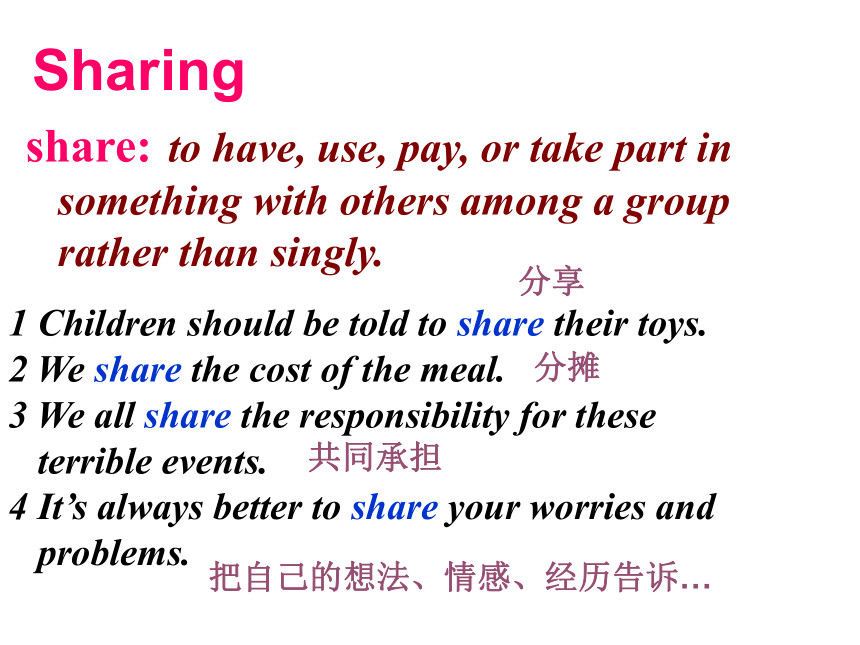
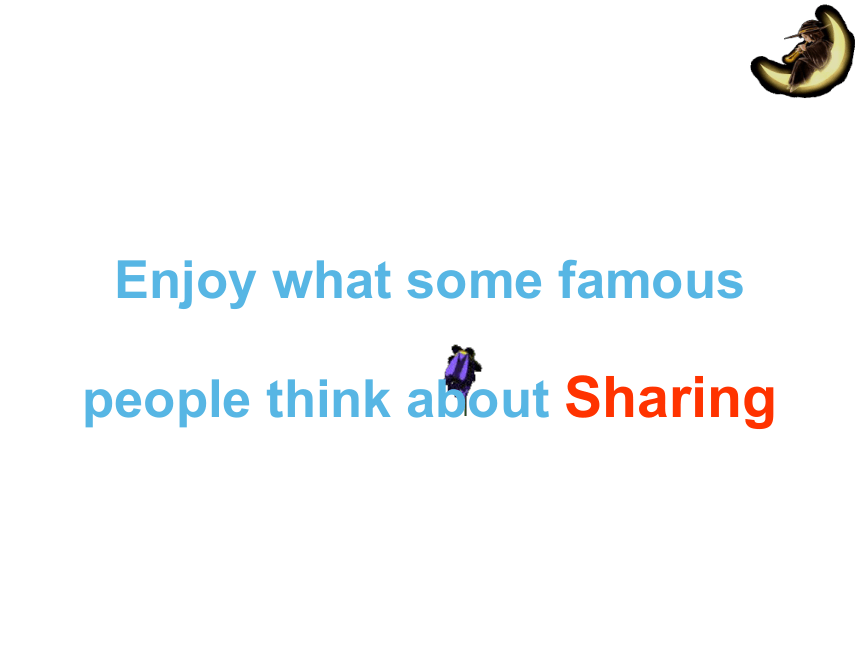

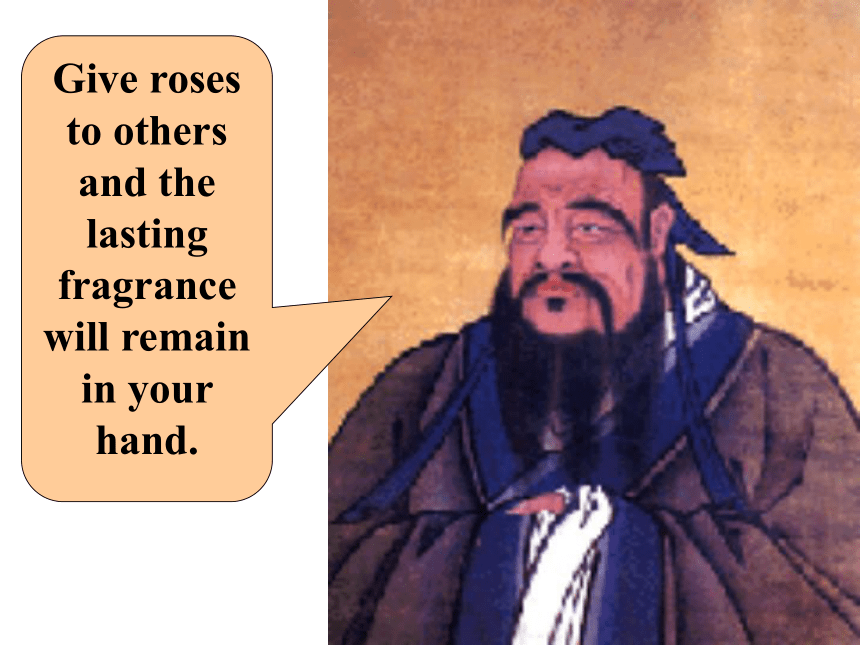

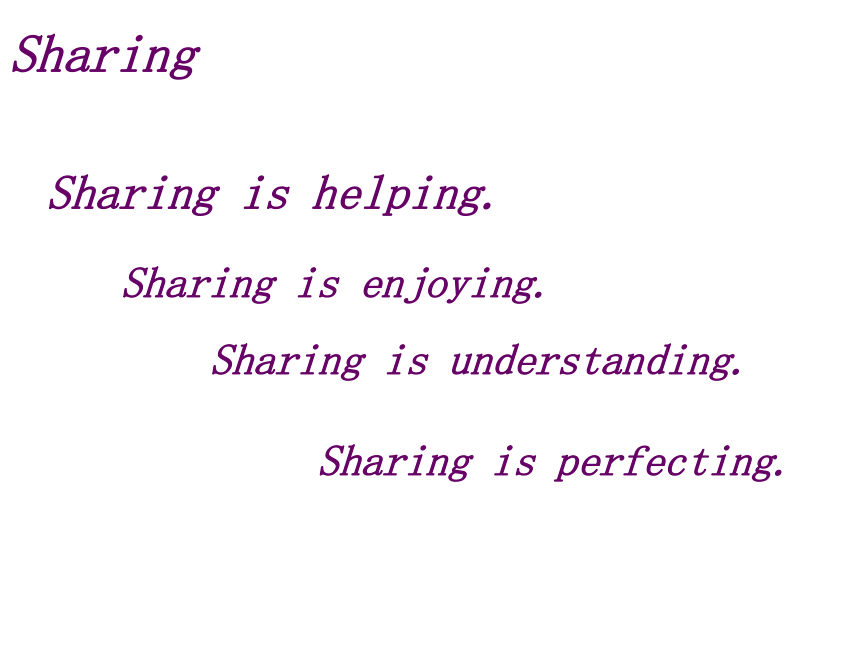

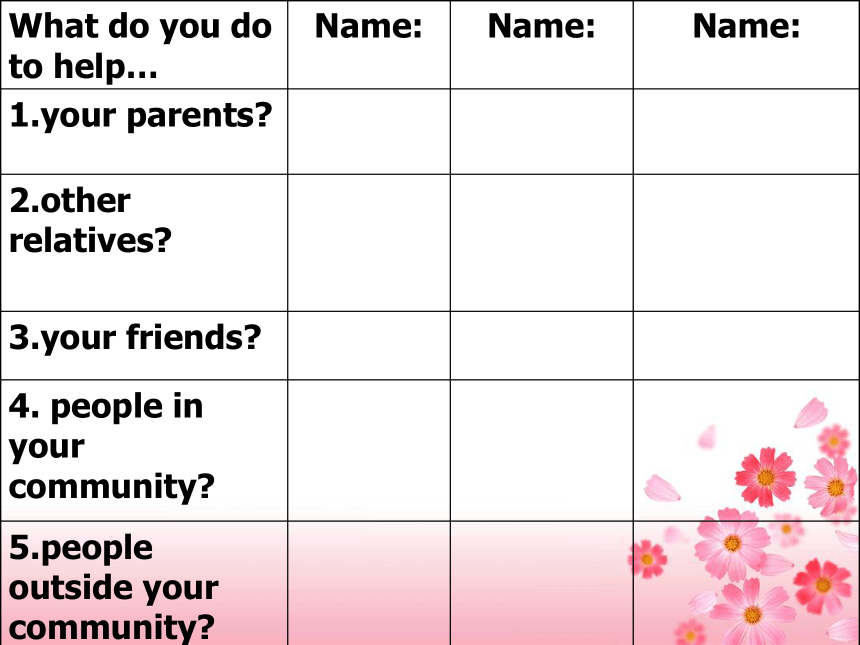


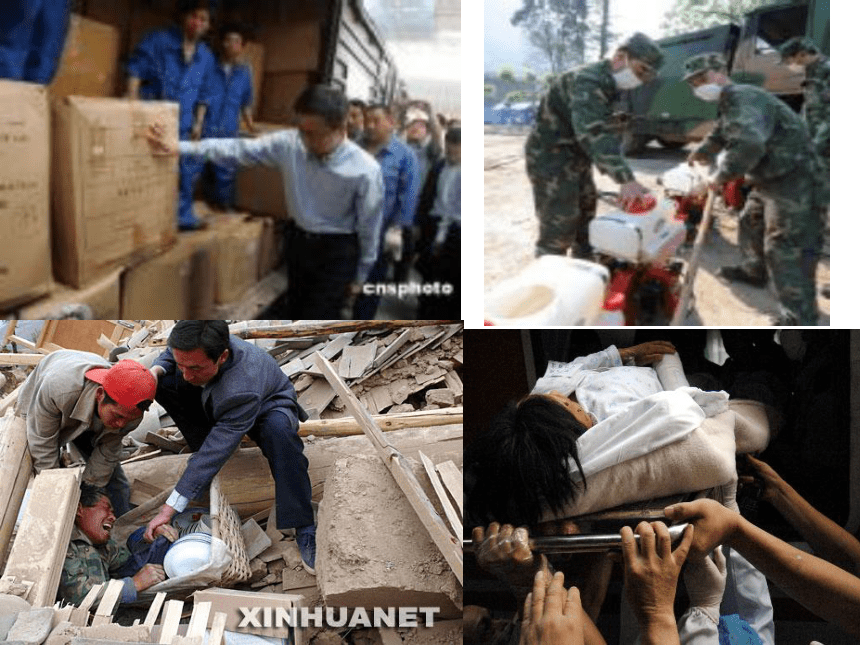
文档简介
课件48张PPT。Unit 4 Sharing
Warming up and reading
Sharingshare: to have, use, pay, or take part in something with others among a group rather than singly. 1 Children should be told to share their toys.
2 We share the cost of the meal.
3 We all share the responsibility for these
terrible events.
4 It’s always better to share your worries and
problems.把自己的想法、情感、经历告诉…共同承担分摊分享Enjoy what some famouspeople think about SharingAs Kofi Annan, Secretary General of the United Nations said “ … each contribution- no matter how small- can help make a difference.”EnjoyGive roses to others and the lasting fragrance will remain in your hand.Be generous and you will be prosperous. Help others and you will be helped.SharingSharing is helping.
Sharing is enjoying.
Sharing is understanding.Sharing is perfecting. Warming upThink about the things you do to help other people. Interview your partner about this.plant treesteach the kids in the mountainous areasWork as a Volunteer in Wenchuan?Teach the kids in the mountainous areasWhat is a volunteer?plant treeshelp the disabledclean the communityteach the kids in the mountainous areaswork not for rewards People who help others in their community or outside their community would be called volunteers. However, they would not be called volunteers if they help their parents, other relatives or friends.What do the signs stand for?The sign of United Nations Volunteer in China (中国青年志愿者)北京2008年奥运会志愿者标志 March,5th is UNV day.
80,000,000 volunteers
in ChinaDecember,5th is International Volunteer DayA Letter Home --By Jo
(a volunteer works in
Papua New Guinea)Discussion1.What’s the full name of this country?
2.Where is PNG?
3.Where is it’s capital?
4.What language do the people there speak?
5.What else do you know about this country?Independent State of Papua New Guinea 巴布亚新几内亚国旗和国徽(极乐鸟 ) 巴布亚在马来语中意为“卷发人”。
16世纪中叶,葡萄牙人来到该岛时,见当地
居民和自然景观很像非洲的几内亚,故称之
为新几内亚. PNG’s national flag and national emblem(国徽)
PNG’s paper currencyPre-reading Look at the photos from Jo and answer the questions.My Class1. What was Jo’s job in PNG?
2. What kind of students were in her class? Boys, girls, or both?
Jo was a teacher in PNG. Boys.3. What were the classrooms like?
Is the classroom well equipped?
No. The classrooms are very poor, made from bamboo and grass.Students putting new grass on classroom roofBuilding a new science labView of the village from the ridge4. What can you say about the village? Is it rich?
The village was a place full of natural beauties. There are more trees and bamboos. It’s poor. Village hutListening: find out the names1________ will receive this letter from Jo.
2_____ become a lot more imaginative in teaching.
3 ___________ did visit a village that was the home of one of the boys, Tombe.
4._____ started crying “ieee ieee” to welcome them.
5 _______ led us to his house, a low bamboo hut.
6 ____ was going to share the platform with Jenny and Jo.RosemaryJoJo and JennyKiakMukapKiakReading comprehensionRead the passage quickly and then choose the best answers.1. The purpose that the author wrote the letter is that ___.
A. she wanted to tell Rosemary her teaching life in the high school.
B. she wanted to tell Rosemary her learning life in the high school.
C. she wanted to tell Rosemary that she couldn’t get any money by teaching the poor students
D. she wanted to tell Rosemary how happy she was in the small village.
2. Why does Jo wonder how relevant chemistry is to the kids?
A. Because she thinks chemistry is too difficult to learn.
B. Because she thinks chemistry may make little difference to the kids’ life.
C. Because the kids there hardly come across anything of chemistry.
D. Because she thinks chemistry useless.
3. By writing “The only possessions that I could see were…”, the author wants to tell us ____.
A. Tombe’s family were kind-hearted
B. Tombe’s family were guest-lovers
C. Tombe’s family only used simple things
D. Tombe’s family were too poor
4. Why did Tombe throw out the tin can?
A. Because he believed the can attracted
evil spirits.
B. Because he believed any leftovers
attracted evil spirits.
C. Because he believed the can has no use
at all.
D. Because he believed the grill attracted evil
spirits.5. How did Jo feel after the visit to
Tombe’s family?
A. Happy.
B. Sad.
C. Worried.
D. Upset.Scann and try to divide it into four parts, and summarize what each part is about. Structure
Part 1(Para 1) :
Part 2(Para____):
Part 3 (Para____):
Part 4 (Para 10):
how Jo gets to know the local people.
End of the letter.
Opening of the letter and introduction to what will be talked about in the passage.
The school where Jo works and Jo’s work at school.
Match each part with its main idea2-34-9A. They left and felt privileged.
B. We had a meal and I saw a strange custom.
C. The poor condition of the room.
D. A special custom of the tin can.B ACDTalk about Part3What did Jo share with her students?Teaching is quite ________________.
Jo should be quite _______________.challengingimaginativeSharing is enjoyingRead the passage carefully to complete the tables below!Reading carefullyabout 5.7 millionEnglish as the official language. Pidgin English as the language for communicationa poor country with most people living in tribal(部落的) villages and depending on subsistence farming(少有余粮的农场经营) to make a livingAbout 85% of children start school but only about 60% of them reach Year 8PopulationLanguageEconomyEducation Read the Para 4-6 carefully to complete the tables belowMade from bamboo and the roofs from grassEveryone seemed to be a relative of each otherANSWERSHeat stones first, and then put them in an empty oil drum with kau kau, corn and greens. Cover them with banana leaves and leave them to steam.Newly made platform for visitors in the father’s room; the mother usually sleep in her own hutKau kau, corn and greensA few tin plates and cups and a couple of potsDigging up peanuts with primitive tools; grow kau kau, corn and greensThey believe there are evil spirits that are usually attracted by leftover foodGroup work: Share Tombe’s story with the world.
Tell what his life is like.Tombe is a boy living in PNG….Sharing is perfectingHomework 1. Read the passage again after class and find all the attributive clauses in it.
2. Preparations: Learning about Language on Page 32. Ex1&2
Warming up and reading
Sharingshare: to have, use, pay, or take part in something with others among a group rather than singly. 1 Children should be told to share their toys.
2 We share the cost of the meal.
3 We all share the responsibility for these
terrible events.
4 It’s always better to share your worries and
problems.把自己的想法、情感、经历告诉…共同承担分摊分享Enjoy what some famouspeople think about SharingAs Kofi Annan, Secretary General of the United Nations said “ … each contribution- no matter how small- can help make a difference.”EnjoyGive roses to others and the lasting fragrance will remain in your hand.Be generous and you will be prosperous. Help others and you will be helped.SharingSharing is helping.
Sharing is enjoying.
Sharing is understanding.Sharing is perfecting. Warming upThink about the things you do to help other people. Interview your partner about this.plant treesteach the kids in the mountainous areasWork as a Volunteer in Wenchuan?Teach the kids in the mountainous areasWhat is a volunteer?plant treeshelp the disabledclean the communityteach the kids in the mountainous areaswork not for rewards People who help others in their community or outside their community would be called volunteers. However, they would not be called volunteers if they help their parents, other relatives or friends.What do the signs stand for?The sign of United Nations Volunteer in China (中国青年志愿者)北京2008年奥运会志愿者标志 March,5th is UNV day.
80,000,000 volunteers
in ChinaDecember,5th is International Volunteer DayA Letter Home --By Jo
(a volunteer works in
Papua New Guinea)Discussion1.What’s the full name of this country?
2.Where is PNG?
3.Where is it’s capital?
4.What language do the people there speak?
5.What else do you know about this country?Independent State of Papua New Guinea 巴布亚新几内亚国旗和国徽(极乐鸟 ) 巴布亚在马来语中意为“卷发人”。
16世纪中叶,葡萄牙人来到该岛时,见当地
居民和自然景观很像非洲的几内亚,故称之
为新几内亚. PNG’s national flag and national emblem(国徽)
PNG’s paper currencyPre-reading Look at the photos from Jo and answer the questions.My Class1. What was Jo’s job in PNG?
2. What kind of students were in her class? Boys, girls, or both?
Jo was a teacher in PNG. Boys.3. What were the classrooms like?
Is the classroom well equipped?
No. The classrooms are very poor, made from bamboo and grass.Students putting new grass on classroom roofBuilding a new science labView of the village from the ridge4. What can you say about the village? Is it rich?
The village was a place full of natural beauties. There are more trees and bamboos. It’s poor. Village hutListening: find out the names1________ will receive this letter from Jo.
2_____ become a lot more imaginative in teaching.
3 ___________ did visit a village that was the home of one of the boys, Tombe.
4._____ started crying “ieee ieee” to welcome them.
5 _______ led us to his house, a low bamboo hut.
6 ____ was going to share the platform with Jenny and Jo.RosemaryJoJo and JennyKiakMukapKiakReading comprehensionRead the passage quickly and then choose the best answers.1. The purpose that the author wrote the letter is that ___.
A. she wanted to tell Rosemary her teaching life in the high school.
B. she wanted to tell Rosemary her learning life in the high school.
C. she wanted to tell Rosemary that she couldn’t get any money by teaching the poor students
D. she wanted to tell Rosemary how happy she was in the small village.
2. Why does Jo wonder how relevant chemistry is to the kids?
A. Because she thinks chemistry is too difficult to learn.
B. Because she thinks chemistry may make little difference to the kids’ life.
C. Because the kids there hardly come across anything of chemistry.
D. Because she thinks chemistry useless.
3. By writing “The only possessions that I could see were…”, the author wants to tell us ____.
A. Tombe’s family were kind-hearted
B. Tombe’s family were guest-lovers
C. Tombe’s family only used simple things
D. Tombe’s family were too poor
4. Why did Tombe throw out the tin can?
A. Because he believed the can attracted
evil spirits.
B. Because he believed any leftovers
attracted evil spirits.
C. Because he believed the can has no use
at all.
D. Because he believed the grill attracted evil
spirits.5. How did Jo feel after the visit to
Tombe’s family?
A. Happy.
B. Sad.
C. Worried.
D. Upset.Scann and try to divide it into four parts, and summarize what each part is about. Structure
Part 1(Para 1) :
Part 2(Para____):
Part 3 (Para____):
Part 4 (Para 10):
how Jo gets to know the local people.
End of the letter.
Opening of the letter and introduction to what will be talked about in the passage.
The school where Jo works and Jo’s work at school.
Match each part with its main idea2-34-9A. They left and felt privileged.
B. We had a meal and I saw a strange custom.
C. The poor condition of the room.
D. A special custom of the tin can.B ACDTalk about Part3What did Jo share with her students?Teaching is quite ________________.
Jo should be quite _______________.challengingimaginativeSharing is enjoyingRead the passage carefully to complete the tables below!Reading carefullyabout 5.7 millionEnglish as the official language. Pidgin English as the language for communicationa poor country with most people living in tribal(部落的) villages and depending on subsistence farming(少有余粮的农场经营) to make a livingAbout 85% of children start school but only about 60% of them reach Year 8PopulationLanguageEconomyEducation Read the Para 4-6 carefully to complete the tables belowMade from bamboo and the roofs from grassEveryone seemed to be a relative of each otherANSWERSHeat stones first, and then put them in an empty oil drum with kau kau, corn and greens. Cover them with banana leaves and leave them to steam.Newly made platform for visitors in the father’s room; the mother usually sleep in her own hutKau kau, corn and greensA few tin plates and cups and a couple of potsDigging up peanuts with primitive tools; grow kau kau, corn and greensThey believe there are evil spirits that are usually attracted by leftover foodGroup work: Share Tombe’s story with the world.
Tell what his life is like.Tombe is a boy living in PNG….Sharing is perfectingHomework 1. Read the passage again after class and find all the attributive clauses in it.
2. Preparations: Learning about Language on Page 32. Ex1&2
